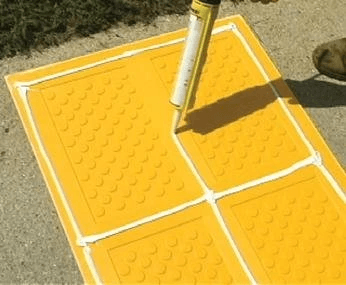-->

How are Detectable Warning Surfaces Redefining Road Safety for Pedestrians?
Conforming to on-road safety rules and regulations while battling visual impairment or disorder is by far one of the most daunting risks pedestrians with visual shortcomings face on road. From zebra crossing during the rush hour to miscalculating the sidewalk curb, visual disability comes with its own set of on-road challenges. However, what seems like a challenge to the visually impaired might just be whimsical carelessness for other pedestrians leading to some notorious road accidents. Acknowledging this concern and acting upon it, ADA Solutions started creating tactile warning surfaces to improve mobility and safety issues for pedestrians on road.
Explaining Pedestrian Problems
Detectable surfaces on the road are not just about safety and precautions. Sometimes, all you need is a direction sign on the road pointing you towards the right direction when you’re lost. Apart from ADA Solutions' truncated domes for on-road safety, ADA has also come up with cast-in-place, photoluminescent systems, way-finding surfaces, and more; focusing on creating seamless on-road experiences for pedestrians for quite a while now.
But before we tell you how ADA solutions truncated domes help pedestrian, take a look at this statistics-
- Only 2% of visually impaired pedestrians use a guide dog
- Only 2% of visually impaired pedestrians use a can for guidance
- More than 560,000 visually impaired patients choose to be home-bound because of their condition
- A whopping 91% of visually impaired pedestrians face on-road atrocities
Endless hurdles, traffic, subway stairs, sidewalk ledges or curbs contribute to on-road accidents. For many, these might be minor and negligible hiccups, but to a visually impaired citizen, this might be a hellish hurdle to maneuver. So, how can detectable warning surfaces help? By appealing to the three primary sensory signals-
Touch- Tactile warning surfaces are usually manufactured with raised bumps or ridges allowing people with complete visual impairment a chance to feel the change in surface.
Sight- Sometimes, partial visual impairment or certain visual disability can be addressed by using vibrant colored tactile surfaces that stand out and notifies the pedestrian of a change.
Hearing- Walking with a crutch or rolling on your wheelchair over the ADA solutions truncated domes will often cause a change in noise thanks to the tactile surface. This too acts as a notifier for certain pedestrians.
Curbing road safety for one and all
If you think detectable warning surfaces or truncated domes were just for the visually impaired, think again. Innumerable people walking down the lane, engrossed in their phones, carelessly zoning out or confidently listening to music on full blast while crossing the road needs to be taken into account too. This means tactile surfaces can be a boon to everyone, regardless of their visual power.
Summing it up
Ada solutions truncated domes and alternative tactile surfaces can enhance on-road or sidewalk experience for pedestrians. Being highly wear-resistant, slip-resistant, and UV protected, these long-term, sturdy visual cues can be the missing thread that redefines on-road safety.


